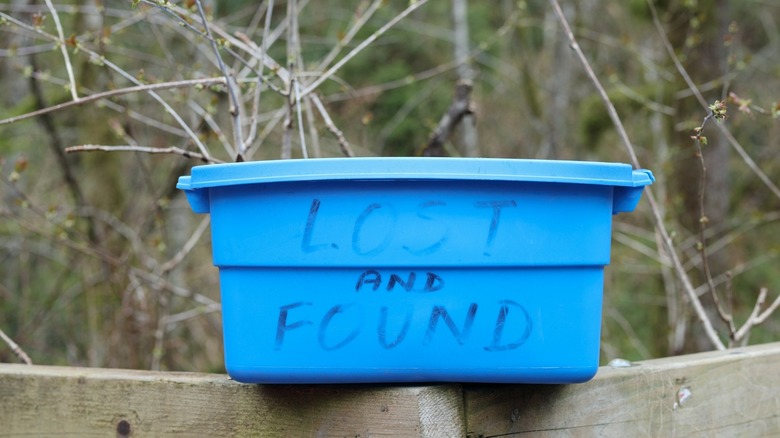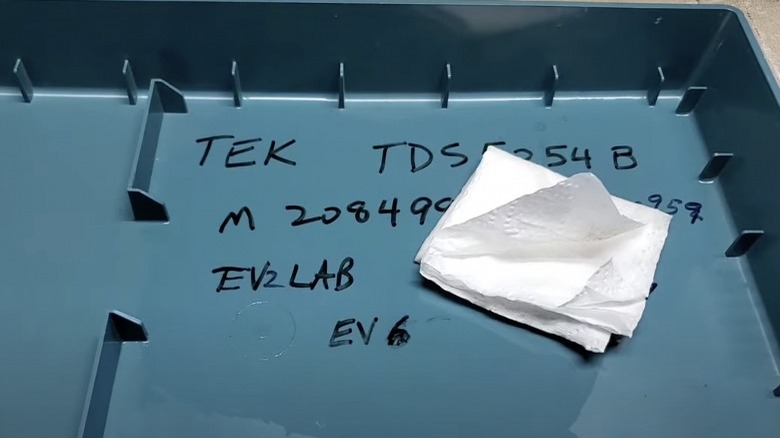The Medicine Cabinet Essential That Can Lift Marker Stains From Plastic Surfaces
The term "permanent" in permanent markers can make their stains seem pretty daunting. But here's some good news: despite what their name suggests, stains from permanent markers aren't stuck with you forever. In fact, a common item in your medicine cabinet, hydrogen peroxide, can be your secret weapon in tackling these stubborn ink stains.
Permanent markers like Sharpie are tough to remove because they contain water-insoluble ink and solvents or volatile organic compounds (VOCs) that quickly evaporate in the air, helping the ink to dry fast and adhere firmly to surfaces. Fortunately, the bleaching properties of hydrogen peroxide allow it to oxidize most stains, effectively breaking them down at a molecular level. For ink stains, the process involves degrading the strong chemical bonds in ink, particularly targeting the components that give the ink its color. By attacking these color-causing sections of the chemical structure, hydrogen peroxide can reduce the visibility of the stain.
How to remove ink stains using hydrogen peroxide
It's important to note that hydrogen peroxide is a strong stain remover and bleaching agent. So, while it may not harm white and transparent plastics, it might bleach colored ones. Also, leaving hydrogen peroxide on the surface for too long or scrubbing too vigorously can damage the plastic's surface or remove the plastic's color. To be sure, do a spot test on an inconspicuous area of the container to ensure it doesn't cause discoloration or damage. Also, keep the hydrogen peroxide away from your carpet and clothes, as this may strip the fabric's color.
Get a cotton ball or a clean cloth and dampen it with hydrogen peroxide. Blot the stain; avoid rubbing to prevent the surface of the plastic from getting damaged. Wash the plastic in soapy water or wipe it off with a damp cloth. If hydrogen peroxide doesn't entirely remove the stain, you might find success by adding a bit of baking soda to the area. Baking soda works as a mild abrasive, aiding in lifting the ink away from the plastic surface.
What to do if hydrogen peroxide doesn't work
Most hydrogen peroxides sold in drug stores only contain 3% hydrogen peroxide and 97% water. If you want to try using hydrogen peroxide in higher concentrations, local beauty supply stores sell them as volume developers. For example, 20 volume developers contain 6% hydrogen peroxide in cream base, while 30 volume developers have 9% of the oxidizing agent. So, if you have a volume developer at home, you might want to try using it to remove the ink stain. In fact, it has been used to remove stains from stones, like marble.
If hydrogen peroxide doesn't successfully remove a permanent ink stain from plastic, permanent marker stains will be a thing of the past with alcohol. Just use it in a similar manner as hydrogen peroxide. Alcohol acts as a solvent, breaking down ink compounds on a molecular level.
Lemon essential oil is another handy option. Just put a single drop directly into the stain, allow it to soak for a few minutes, and then wipe away with a cloth. Alternatively, using fresh lemon juice can also serve the same purpose. Like lemon, vinegar has mild acidic properties that help remove ink stains.
For tougher stains, nail polish remover containing acetone is another option. Acetone is particularly effective at dissolving many types of inks and paints, making it a strong choice for cleaning plastic surfaces. Likewise, permanent marker doesn't stand a chance against another favorite household staple: WD-40.


